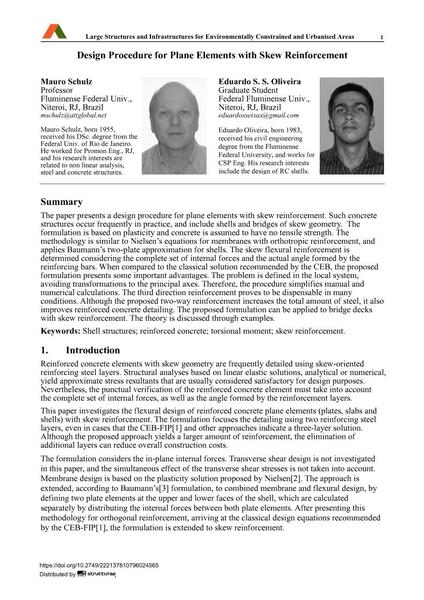Design Procedure for Plane Elements with Skew Reinforcement

|
|
|||||||||||
Détails bibliographiques
| Auteur(s): |
Mauro Schulz
Eduardo Silva de Seixas Oliveira |
||||
|---|---|---|---|---|---|
| Médium: | papier de conférence | ||||
| Langue(s): | anglais | ||||
| Conférence: | IABSE Symposium: Large Structures and Infrastructures for Environmentally Constrained and Urbanised Areas, Venice, Italy, 22-24 September 2010 | ||||
| Publié dans: | IABSE Symposium Venice 2010 | ||||
|
|||||
| Page(s): | 280-281 | ||||
| Nombre total de pages (du PDF): | 8 | ||||
| Année: | 2010 | ||||
| DOI: | 10.2749/222137810796024565 | ||||
| Abstrait: |
The paper presents a design procedure for plane elements with skew reinforcement. Such concrete structures occur frequently in practice, and include shells and bridges of skew geometry. The formulation is based on plasticity and concrete is assumed to have no tensile strength. The methodology is similar to Nielsen’s equations for membranes with orthotropic reinforcement, and applies Baumann’s two-plate approximation for shells. The skew flexural reinforcement is determined considering the complete set of internal forces and the actual angle formed by the reinforcing bars. When compared to the classical solution recommended by the CEB, the proposed formulation presents some important advantages. The problem is defined in the local system, avoiding transformations to the principal axes. Therefore, the procedure simplifies manual and numerical calculations. The third direction reinforcement proves to be dispensable in many conditions. Although the proposed two-way reinforcement increases the total amount of steel, it also improves reinforced concrete detailing. The proposed formulation can be applied to bridge decks with skew reinforcement. The theory is discussed through examples. |
||||
